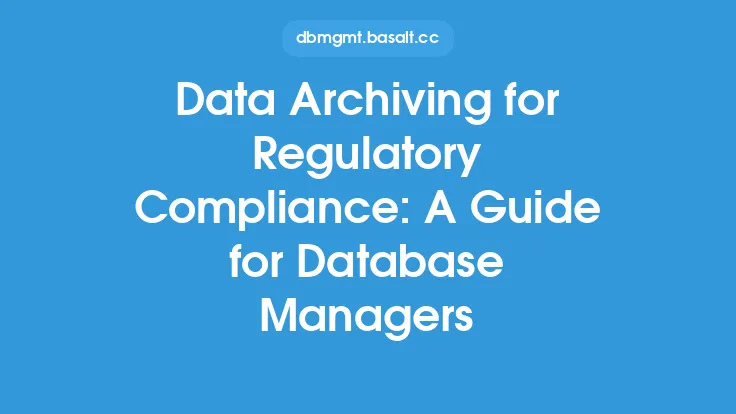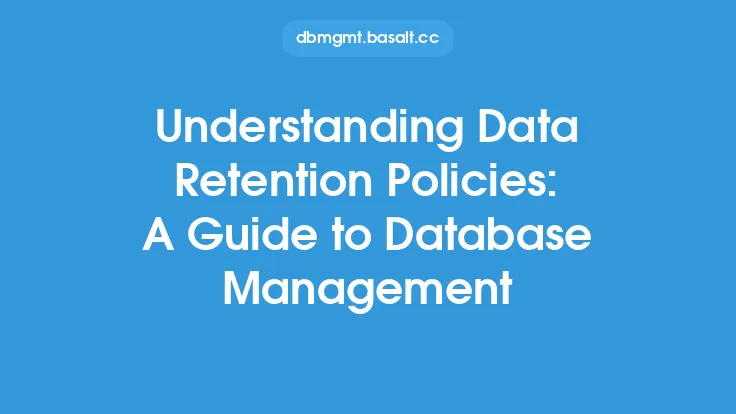As a database manager, it is essential to understand the importance of data retention and compliance in maintaining the integrity and security of your organization's data. Data retention refers to the policies and procedures that govern how long data is stored, archived, and eventually deleted. Compliance, on the other hand, refers to the adherence to laws, regulations, and industry standards that dictate how data is handled and protected. In this article, we will delve into the world of data retention and compliance, exploring the key concepts, best practices, and considerations that database managers need to know.
Introduction to Data Retention
Data retention is a critical aspect of database management, as it ensures that data is stored for the appropriate amount of time to meet business, legal, and regulatory requirements. A well-designed data retention policy takes into account the type of data, its sensitivity, and its usefulness to the organization. It also considers the storage capacity, data growth, and the potential risks associated with data retention, such as data breaches and non-compliance. Database managers must balance the need to retain data with the need to delete or archive data that is no longer necessary or relevant.
Compliance Frameworks and Regulations
Compliance frameworks and regulations play a significant role in shaping data retention policies. Organizations must comply with various laws, regulations, and industry standards, such as the General Data Protection Regulation (GDPR), the Health Insurance Portability and Accountability Act (HIPAA), and the Payment Card Industry Data Security Standard (PCI DSS). These regulations dictate how data is collected, stored, processed, and deleted, and non-compliance can result in significant fines and reputational damage. Database managers must stay up-to-date with the latest regulations and ensure that their data retention policies align with these requirements.
Data Classification and Categorization
Data classification and categorization are essential components of a data retention policy. Data can be classified into different categories, such as sensitive, confidential, or public, based on its sensitivity and importance. Each category has its own set of retention rules, access controls, and security measures. Database managers must ensure that data is properly classified and categorized to ensure that it is handled and protected accordingly. This includes implementing access controls, encryption, and other security measures to prevent unauthorized access or data breaches.
Data Storage and Archiving
Data storage and archiving are critical components of a data retention policy. Database managers must ensure that data is stored in a secure and accessible manner, using technologies such as disk storage, tape storage, or cloud storage. Archiving involves moving data to a separate storage location, where it can be retained for a longer period. Database managers must consider factors such as data growth, storage capacity, and data retrieval times when designing their data storage and archiving strategies.
Data Deletion and Destruction
Data deletion and destruction are essential components of a data retention policy. Database managers must ensure that data is deleted or destroyed in a secure and permanent manner, using techniques such as encryption, wiping, or physical destruction. This includes ensuring that data is properly removed from all storage locations, including backups and archives. Database managers must also consider the potential risks associated with data deletion, such as data loss or non-compliance.
Auditing and Monitoring
Auditing and monitoring are critical components of a data retention policy. Database managers must ensure that data is properly audited and monitored to detect any unauthorized access, modifications, or deletions. This includes implementing logging and auditing mechanisms, as well as monitoring data storage and archiving systems. Database managers must also ensure that audit logs are properly retained and protected to prevent tampering or alteration.
Training and Awareness
Training and awareness are essential components of a data retention policy. Database managers must ensure that employees and stakeholders are properly trained and aware of the data retention policy and its requirements. This includes providing regular training and updates on data handling, storage, and protection, as well as ensuring that employees understand the importance of data retention and compliance. Database managers must also ensure that employees are aware of the potential risks associated with non-compliance and the consequences of data breaches or unauthorized access.
Conclusion
In conclusion, data retention and compliance are critical aspects of database management, requiring a deep understanding of the key concepts, best practices, and considerations. Database managers must balance the need to retain data with the need to delete or archive data that is no longer necessary or relevant, while ensuring compliance with laws, regulations, and industry standards. By implementing a well-designed data retention policy, database managers can ensure the integrity and security of their organization's data, while minimizing the risks associated with non-compliance and data breaches.





